Deepwater Horizon Disaster: A Project Management Case Analysis
VerifiedAdded on 2023/05/30
|7
|1689
|322
Case Study
AI Summary
This case study examines the Deepwater Horizon disaster, identifying mechanical, technical, human, and legal failures that led to the explosion. Key issues included negligence by BP, an inefficient internal safety culture, and inconsistent regulatory oversight. The analysis highlights missteps such as using cheaper materials, failing to perform acoustic tests, and neglecting essential safety equipment. The study attributes the disaster to greed, poor communication, and inadequate risk assessment. Recommendations include heeding contractor advice, prioritizing safety over cost savings, and improving communication between well site leaders and onshore crew members. External factors, such as the rapid approval of design changes by the United States interior department, also contributed. The study suggests a thorough assessment of well designs before approval to prevent similar disasters. Desklib offers a variety of solved assignments and past papers to aid students in their studies.
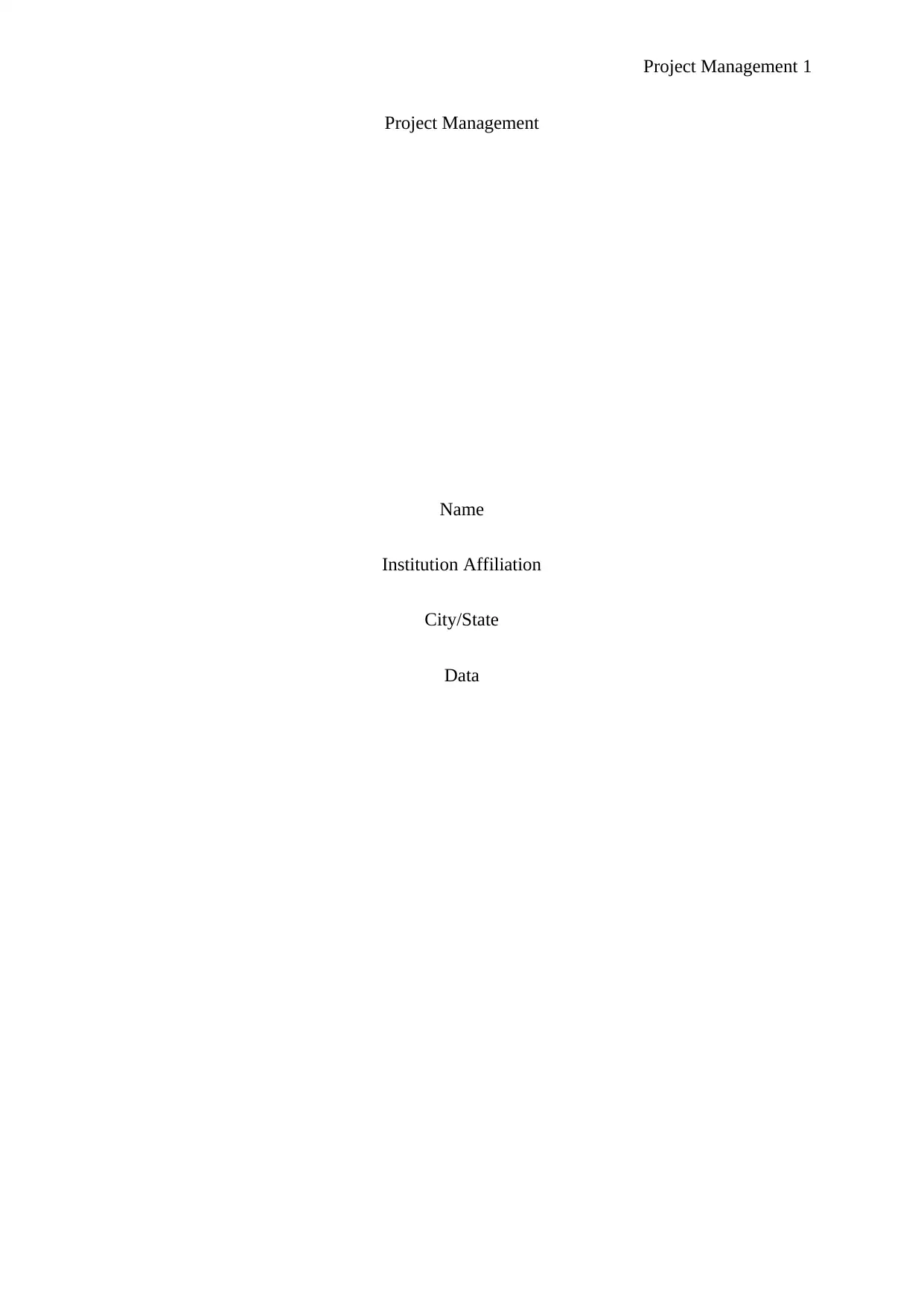
Project Management 1
Project Management
Name
Institution Affiliation
City/State
Data
Project Management
Name
Institution Affiliation
City/State
Data
Paraphrase This Document
Need a fresh take? Get an instant paraphrase of this document with our AI Paraphraser
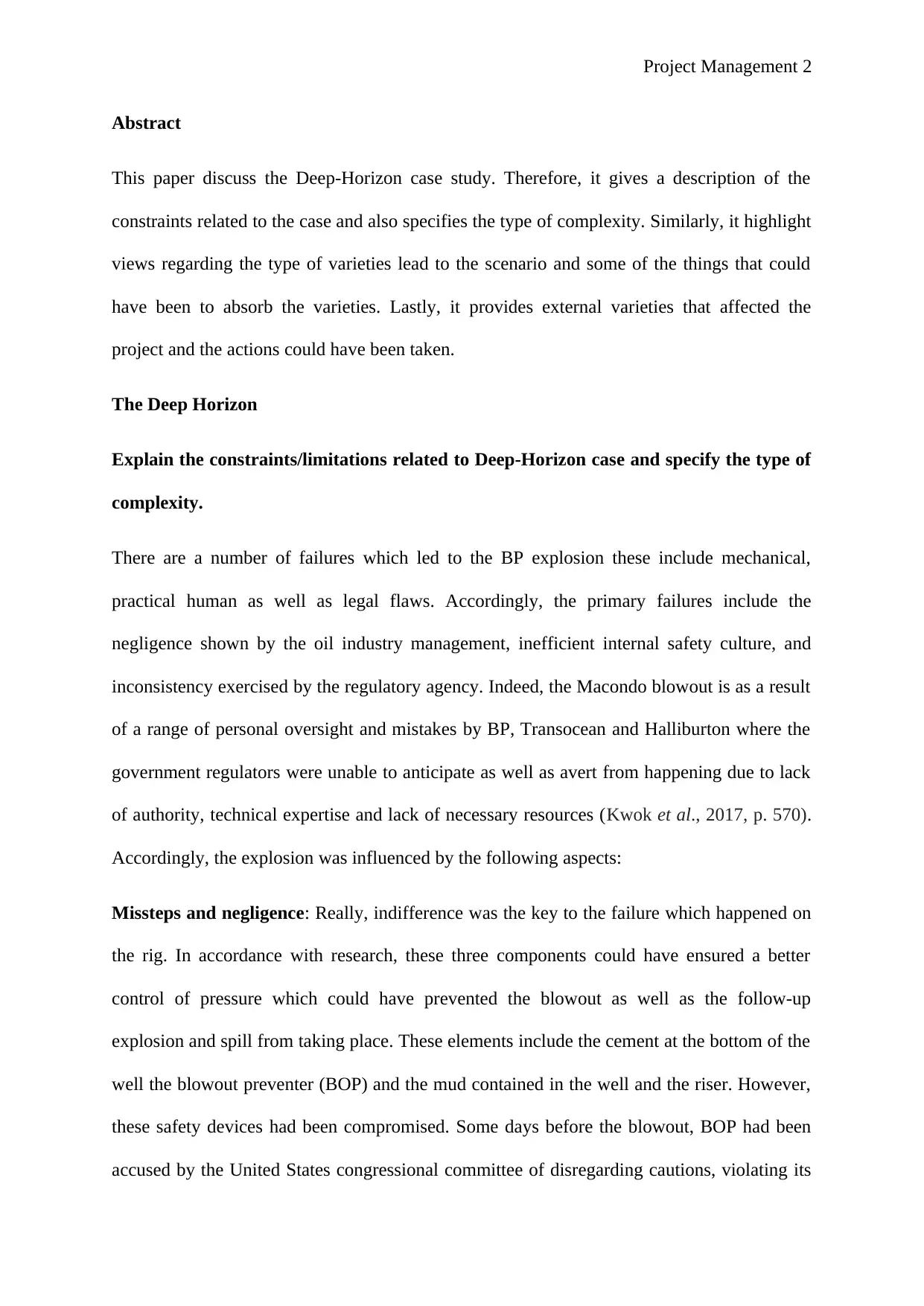
Project Management 2
Abstract
This paper discuss the Deep-Horizon case study. Therefore, it gives a description of the
constraints related to the case and also specifies the type of complexity. Similarly, it highlight
views regarding the type of varieties lead to the scenario and some of the things that could
have been to absorb the varieties. Lastly, it provides external varieties that affected the
project and the actions could have been taken.
The Deep Horizon
Explain the constraints/limitations related to Deep-Horizon case and specify the type of
complexity.
There are a number of failures which led to the BP explosion these include mechanical,
practical human as well as legal flaws. Accordingly, the primary failures include the
negligence shown by the oil industry management, inefficient internal safety culture, and
inconsistency exercised by the regulatory agency. Indeed, the Macondo blowout is as a result
of a range of personal oversight and mistakes by BP, Transocean and Halliburton where the
government regulators were unable to anticipate as well as avert from happening due to lack
of authority, technical expertise and lack of necessary resources (Kwok et al., 2017, p. 570).
Accordingly, the explosion was influenced by the following aspects:
Missteps and negligence: Really, indifference was the key to the failure which happened on
the rig. In accordance with research, these three components could have ensured a better
control of pressure which could have prevented the blowout as well as the follow-up
explosion and spill from taking place. These elements include the cement at the bottom of the
well the blowout preventer (BOP) and the mud contained in the well and the riser. However,
these safety devices had been compromised. Some days before the blowout, BOP had been
accused by the United States congressional committee of disregarding cautions, violating its
Abstract
This paper discuss the Deep-Horizon case study. Therefore, it gives a description of the
constraints related to the case and also specifies the type of complexity. Similarly, it highlight
views regarding the type of varieties lead to the scenario and some of the things that could
have been to absorb the varieties. Lastly, it provides external varieties that affected the
project and the actions could have been taken.
The Deep Horizon
Explain the constraints/limitations related to Deep-Horizon case and specify the type of
complexity.
There are a number of failures which led to the BP explosion these include mechanical,
practical human as well as legal flaws. Accordingly, the primary failures include the
negligence shown by the oil industry management, inefficient internal safety culture, and
inconsistency exercised by the regulatory agency. Indeed, the Macondo blowout is as a result
of a range of personal oversight and mistakes by BP, Transocean and Halliburton where the
government regulators were unable to anticipate as well as avert from happening due to lack
of authority, technical expertise and lack of necessary resources (Kwok et al., 2017, p. 570).
Accordingly, the explosion was influenced by the following aspects:
Missteps and negligence: Really, indifference was the key to the failure which happened on
the rig. In accordance with research, these three components could have ensured a better
control of pressure which could have prevented the blowout as well as the follow-up
explosion and spill from taking place. These elements include the cement at the bottom of the
well the blowout preventer (BOP) and the mud contained in the well and the riser. However,
these safety devices had been compromised. Some days before the blowout, BOP had been
accused by the United States congressional committee of disregarding cautions, violating its
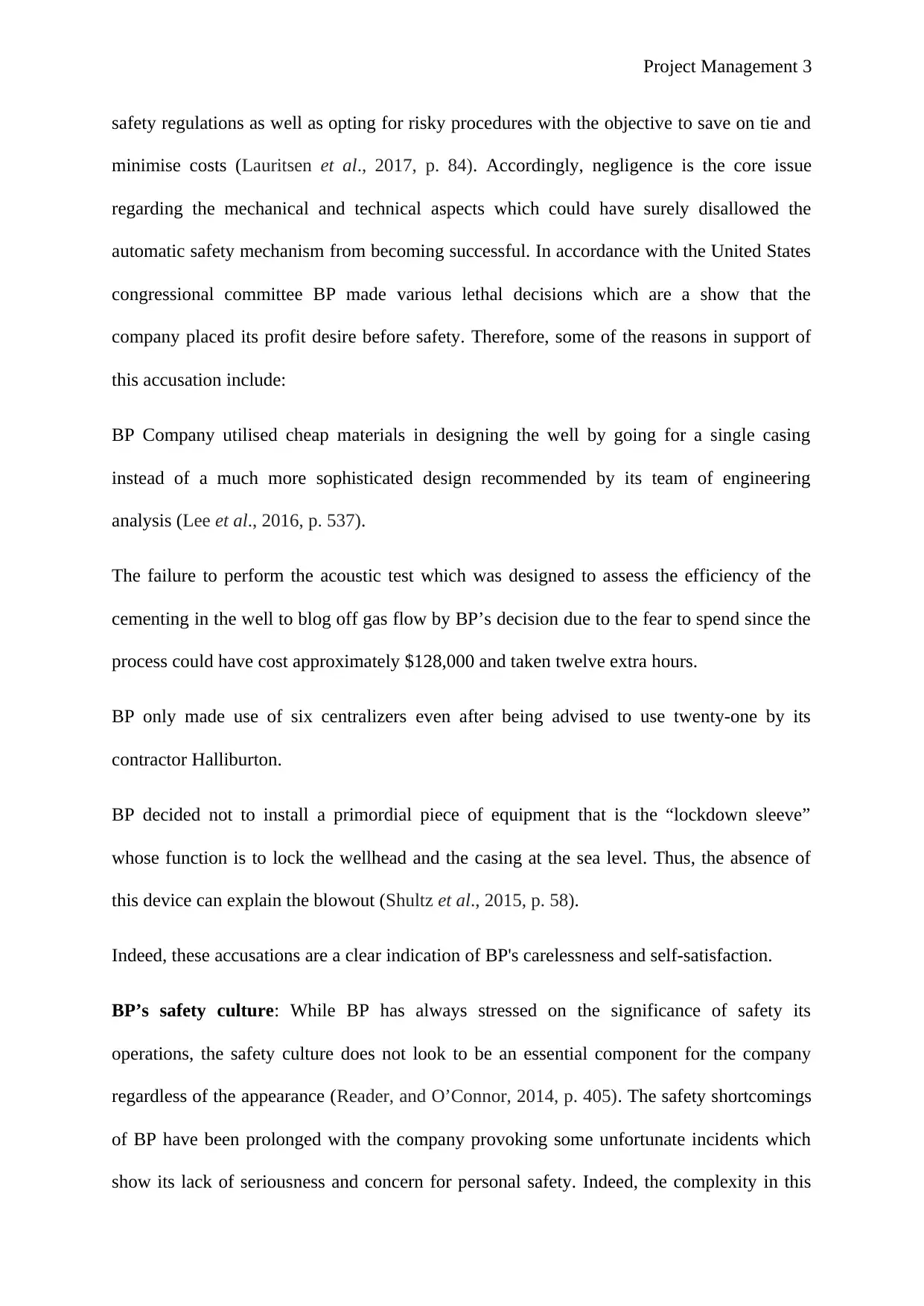
Project Management 3
safety regulations as well as opting for risky procedures with the objective to save on tie and
minimise costs (Lauritsen et al., 2017, p. 84). Accordingly, negligence is the core issue
regarding the mechanical and technical aspects which could have surely disallowed the
automatic safety mechanism from becoming successful. In accordance with the United States
congressional committee BP made various lethal decisions which are a show that the
company placed its profit desire before safety. Therefore, some of the reasons in support of
this accusation include:
BP Company utilised cheap materials in designing the well by going for a single casing
instead of a much more sophisticated design recommended by its team of engineering
analysis (Lee et al., 2016, p. 537).
The failure to perform the acoustic test which was designed to assess the efficiency of the
cementing in the well to blog off gas flow by BP’s decision due to the fear to spend since the
process could have cost approximately $128,000 and taken twelve extra hours.
BP only made use of six centralizers even after being advised to use twenty-one by its
contractor Halliburton.
BP decided not to install a primordial piece of equipment that is the “lockdown sleeve”
whose function is to lock the wellhead and the casing at the sea level. Thus, the absence of
this device can explain the blowout (Shultz et al., 2015, p. 58).
Indeed, these accusations are a clear indication of BP's carelessness and self-satisfaction.
BP’s safety culture: While BP has always stressed on the significance of safety its
operations, the safety culture does not look to be an essential component for the company
regardless of the appearance (Reader, and O’Connor, 2014, p. 405). The safety shortcomings
of BP have been prolonged with the company provoking some unfortunate incidents which
show its lack of seriousness and concern for personal safety. Indeed, the complexity in this
safety regulations as well as opting for risky procedures with the objective to save on tie and
minimise costs (Lauritsen et al., 2017, p. 84). Accordingly, negligence is the core issue
regarding the mechanical and technical aspects which could have surely disallowed the
automatic safety mechanism from becoming successful. In accordance with the United States
congressional committee BP made various lethal decisions which are a show that the
company placed its profit desire before safety. Therefore, some of the reasons in support of
this accusation include:
BP Company utilised cheap materials in designing the well by going for a single casing
instead of a much more sophisticated design recommended by its team of engineering
analysis (Lee et al., 2016, p. 537).
The failure to perform the acoustic test which was designed to assess the efficiency of the
cementing in the well to blog off gas flow by BP’s decision due to the fear to spend since the
process could have cost approximately $128,000 and taken twelve extra hours.
BP only made use of six centralizers even after being advised to use twenty-one by its
contractor Halliburton.
BP decided not to install a primordial piece of equipment that is the “lockdown sleeve”
whose function is to lock the wellhead and the casing at the sea level. Thus, the absence of
this device can explain the blowout (Shultz et al., 2015, p. 58).
Indeed, these accusations are a clear indication of BP's carelessness and self-satisfaction.
BP’s safety culture: While BP has always stressed on the significance of safety its
operations, the safety culture does not look to be an essential component for the company
regardless of the appearance (Reader, and O’Connor, 2014, p. 405). The safety shortcomings
of BP have been prolonged with the company provoking some unfortunate incidents which
show its lack of seriousness and concern for personal safety. Indeed, the complexity in this
⊘ This is a preview!⊘
Do you want full access?
Subscribe today to unlock all pages.

Trusted by 1+ million students worldwide
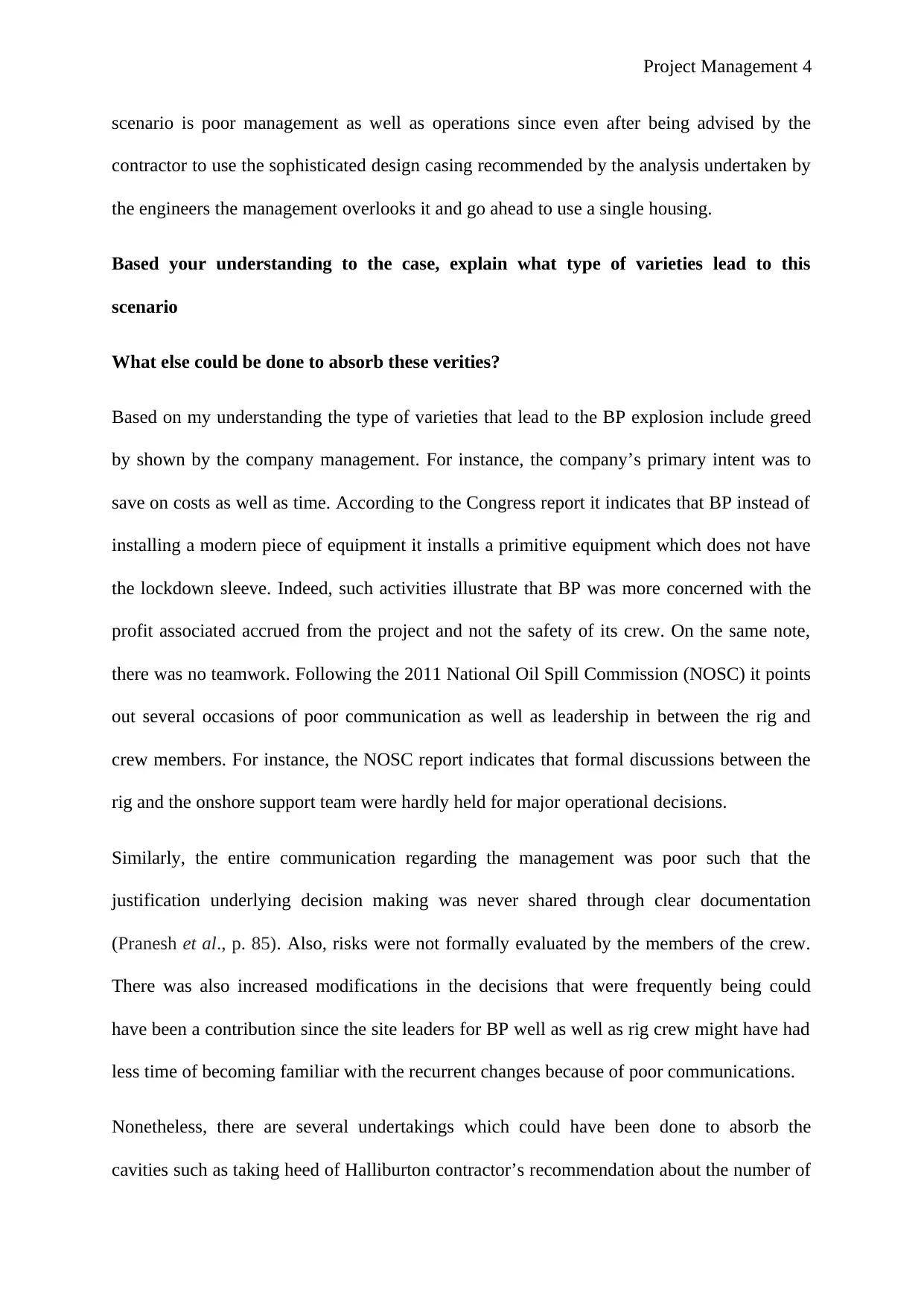
Project Management 4
scenario is poor management as well as operations since even after being advised by the
contractor to use the sophisticated design casing recommended by the analysis undertaken by
the engineers the management overlooks it and go ahead to use a single housing.
Based your understanding to the case, explain what type of varieties lead to this
scenario
What else could be done to absorb these verities?
Based on my understanding the type of varieties that lead to the BP explosion include greed
by shown by the company management. For instance, the company’s primary intent was to
save on costs as well as time. According to the Congress report it indicates that BP instead of
installing a modern piece of equipment it installs a primitive equipment which does not have
the lockdown sleeve. Indeed, such activities illustrate that BP was more concerned with the
profit associated accrued from the project and not the safety of its crew. On the same note,
there was no teamwork. Following the 2011 National Oil Spill Commission (NOSC) it points
out several occasions of poor communication as well as leadership in between the rig and
crew members. For instance, the NOSC report indicates that formal discussions between the
rig and the onshore support team were hardly held for major operational decisions.
Similarly, the entire communication regarding the management was poor such that the
justification underlying decision making was never shared through clear documentation
(Pranesh et al., p. 85). Also, risks were not formally evaluated by the members of the crew.
There was also increased modifications in the decisions that were frequently being could
have been a contribution since the site leaders for BP well as well as rig crew might have had
less time of becoming familiar with the recurrent changes because of poor communications.
Nonetheless, there are several undertakings which could have been done to absorb the
cavities such as taking heed of Halliburton contractor’s recommendation about the number of
scenario is poor management as well as operations since even after being advised by the
contractor to use the sophisticated design casing recommended by the analysis undertaken by
the engineers the management overlooks it and go ahead to use a single housing.
Based your understanding to the case, explain what type of varieties lead to this
scenario
What else could be done to absorb these verities?
Based on my understanding the type of varieties that lead to the BP explosion include greed
by shown by the company management. For instance, the company’s primary intent was to
save on costs as well as time. According to the Congress report it indicates that BP instead of
installing a modern piece of equipment it installs a primitive equipment which does not have
the lockdown sleeve. Indeed, such activities illustrate that BP was more concerned with the
profit associated accrued from the project and not the safety of its crew. On the same note,
there was no teamwork. Following the 2011 National Oil Spill Commission (NOSC) it points
out several occasions of poor communication as well as leadership in between the rig and
crew members. For instance, the NOSC report indicates that formal discussions between the
rig and the onshore support team were hardly held for major operational decisions.
Similarly, the entire communication regarding the management was poor such that the
justification underlying decision making was never shared through clear documentation
(Pranesh et al., p. 85). Also, risks were not formally evaluated by the members of the crew.
There was also increased modifications in the decisions that were frequently being could
have been a contribution since the site leaders for BP well as well as rig crew might have had
less time of becoming familiar with the recurrent changes because of poor communications.
Nonetheless, there are several undertakings which could have been done to absorb the
cavities such as taking heed of Halliburton contractor’s recommendation about the number of
Paraphrase This Document
Need a fresh take? Get an instant paraphrase of this document with our AI Paraphraser
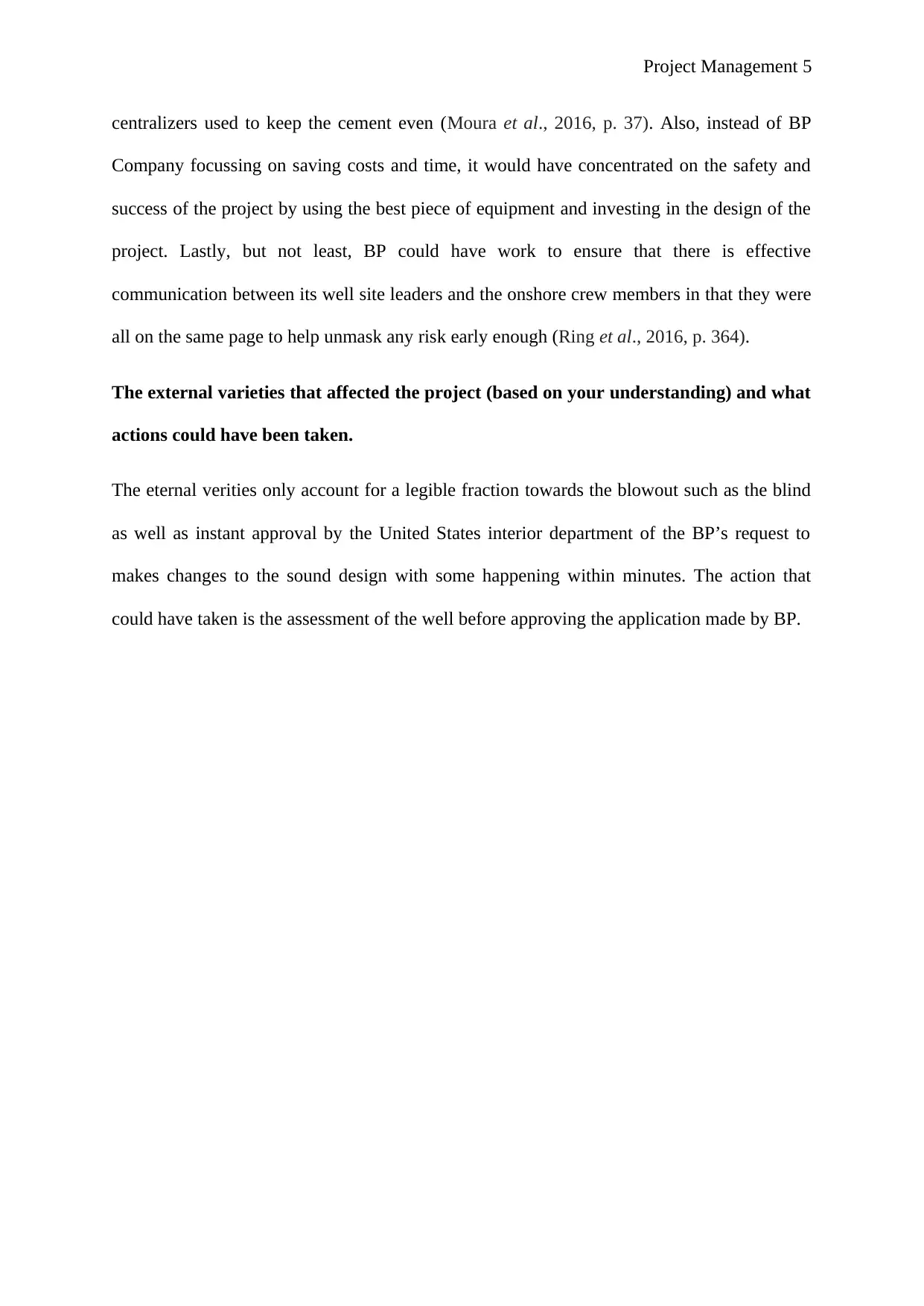
Project Management 5
centralizers used to keep the cement even (Moura et al., 2016, p. 37). Also, instead of BP
Company focussing on saving costs and time, it would have concentrated on the safety and
success of the project by using the best piece of equipment and investing in the design of the
project. Lastly, but not least, BP could have work to ensure that there is effective
communication between its well site leaders and the onshore crew members in that they were
all on the same page to help unmask any risk early enough (Ring et al., 2016, p. 364).
The external varieties that affected the project (based on your understanding) and what
actions could have been taken.
The eternal verities only account for a legible fraction towards the blowout such as the blind
as well as instant approval by the United States interior department of the BP’s request to
makes changes to the sound design with some happening within minutes. The action that
could have taken is the assessment of the well before approving the application made by BP.
centralizers used to keep the cement even (Moura et al., 2016, p. 37). Also, instead of BP
Company focussing on saving costs and time, it would have concentrated on the safety and
success of the project by using the best piece of equipment and investing in the design of the
project. Lastly, but not least, BP could have work to ensure that there is effective
communication between its well site leaders and the onshore crew members in that they were
all on the same page to help unmask any risk early enough (Ring et al., 2016, p. 364).
The external varieties that affected the project (based on your understanding) and what
actions could have been taken.
The eternal verities only account for a legible fraction towards the blowout such as the blind
as well as instant approval by the United States interior department of the BP’s request to
makes changes to the sound design with some happening within minutes. The action that
could have taken is the assessment of the well before approving the application made by BP.
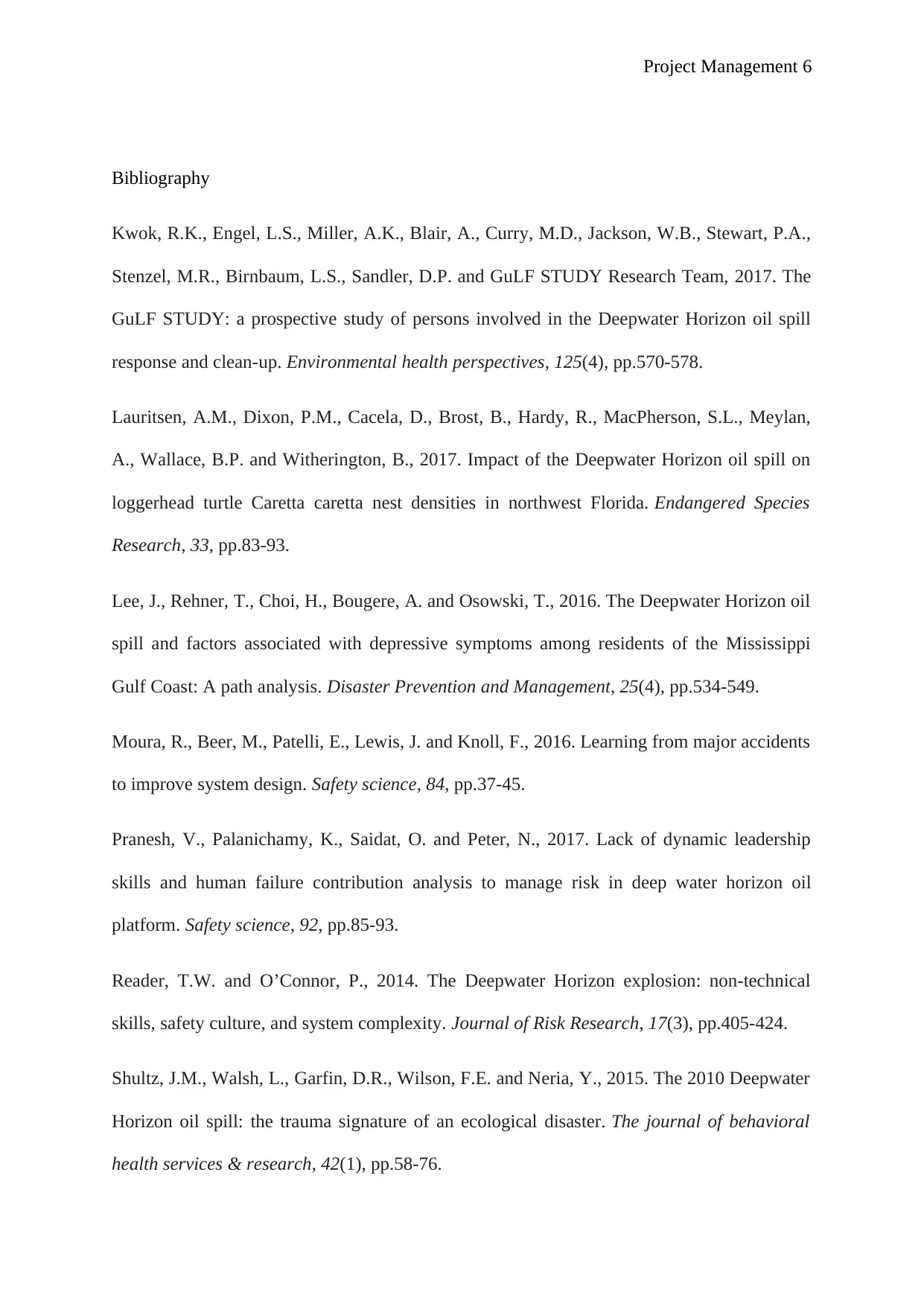
Project Management 6
Bibliography
Kwok, R.K., Engel, L.S., Miller, A.K., Blair, A., Curry, M.D., Jackson, W.B., Stewart, P.A.,
Stenzel, M.R., Birnbaum, L.S., Sandler, D.P. and GuLF STUDY Research Team, 2017. The
GuLF STUDY: a prospective study of persons involved in the Deepwater Horizon oil spill
response and clean-up. Environmental health perspectives, 125(4), pp.570-578.
Lauritsen, A.M., Dixon, P.M., Cacela, D., Brost, B., Hardy, R., MacPherson, S.L., Meylan,
A., Wallace, B.P. and Witherington, B., 2017. Impact of the Deepwater Horizon oil spill on
loggerhead turtle Caretta caretta nest densities in northwest Florida. Endangered Species
Research, 33, pp.83-93.
Lee, J., Rehner, T., Choi, H., Bougere, A. and Osowski, T., 2016. The Deepwater Horizon oil
spill and factors associated with depressive symptoms among residents of the Mississippi
Gulf Coast: A path analysis. Disaster Prevention and Management, 25(4), pp.534-549.
Moura, R., Beer, M., Patelli, E., Lewis, J. and Knoll, F., 2016. Learning from major accidents
to improve system design. Safety science, 84, pp.37-45.
Pranesh, V., Palanichamy, K., Saidat, O. and Peter, N., 2017. Lack of dynamic leadership
skills and human failure contribution analysis to manage risk in deep water horizon oil
platform. Safety science, 92, pp.85-93.
Reader, T.W. and O’Connor, P., 2014. The Deepwater Horizon explosion: non-technical
skills, safety culture, and system complexity. Journal of Risk Research, 17(3), pp.405-424.
Shultz, J.M., Walsh, L., Garfin, D.R., Wilson, F.E. and Neria, Y., 2015. The 2010 Deepwater
Horizon oil spill: the trauma signature of an ecological disaster. The journal of behavioral
health services & research, 42(1), pp.58-76.
Bibliography
Kwok, R.K., Engel, L.S., Miller, A.K., Blair, A., Curry, M.D., Jackson, W.B., Stewart, P.A.,
Stenzel, M.R., Birnbaum, L.S., Sandler, D.P. and GuLF STUDY Research Team, 2017. The
GuLF STUDY: a prospective study of persons involved in the Deepwater Horizon oil spill
response and clean-up. Environmental health perspectives, 125(4), pp.570-578.
Lauritsen, A.M., Dixon, P.M., Cacela, D., Brost, B., Hardy, R., MacPherson, S.L., Meylan,
A., Wallace, B.P. and Witherington, B., 2017. Impact of the Deepwater Horizon oil spill on
loggerhead turtle Caretta caretta nest densities in northwest Florida. Endangered Species
Research, 33, pp.83-93.
Lee, J., Rehner, T., Choi, H., Bougere, A. and Osowski, T., 2016. The Deepwater Horizon oil
spill and factors associated with depressive symptoms among residents of the Mississippi
Gulf Coast: A path analysis. Disaster Prevention and Management, 25(4), pp.534-549.
Moura, R., Beer, M., Patelli, E., Lewis, J. and Knoll, F., 2016. Learning from major accidents
to improve system design. Safety science, 84, pp.37-45.
Pranesh, V., Palanichamy, K., Saidat, O. and Peter, N., 2017. Lack of dynamic leadership
skills and human failure contribution analysis to manage risk in deep water horizon oil
platform. Safety science, 92, pp.85-93.
Reader, T.W. and O’Connor, P., 2014. The Deepwater Horizon explosion: non-technical
skills, safety culture, and system complexity. Journal of Risk Research, 17(3), pp.405-424.
Shultz, J.M., Walsh, L., Garfin, D.R., Wilson, F.E. and Neria, Y., 2015. The 2010 Deepwater
Horizon oil spill: the trauma signature of an ecological disaster. The journal of behavioral
health services & research, 42(1), pp.58-76.
⊘ This is a preview!⊘
Do you want full access?
Subscribe today to unlock all pages.

Trusted by 1+ million students worldwide

Project Management 7
Ring, P.J., Bryce, C., McKinney, R. and Webb, R., 2016. Taking notice of risk culture–the
regulator’s approach. Journal of Risk Research, 19(3), pp.364-387.
Ring, P.J., Bryce, C., McKinney, R. and Webb, R., 2016. Taking notice of risk culture–the
regulator’s approach. Journal of Risk Research, 19(3), pp.364-387.
1 out of 7
Related Documents
Your All-in-One AI-Powered Toolkit for Academic Success.
+13062052269
info@desklib.com
Available 24*7 on WhatsApp / Email
![[object Object]](/_next/static/media/star-bottom.7253800d.svg)
Unlock your academic potential
Copyright © 2020–2025 A2Z Services. All Rights Reserved. Developed and managed by ZUCOL.



